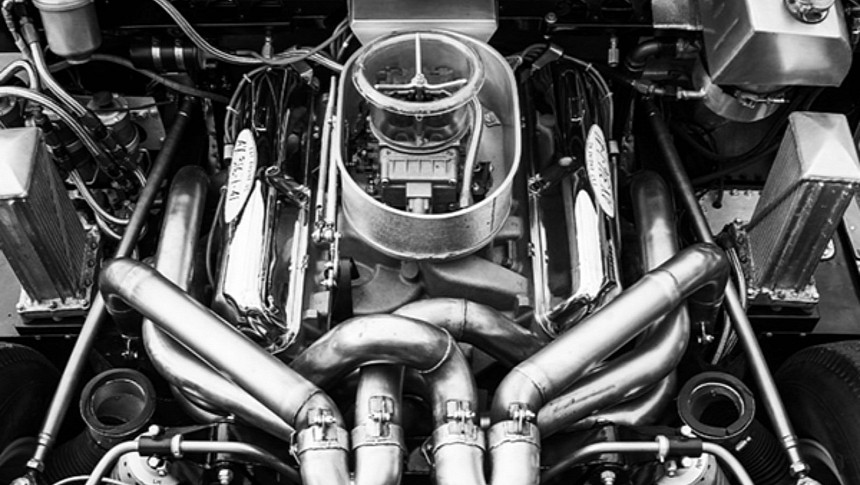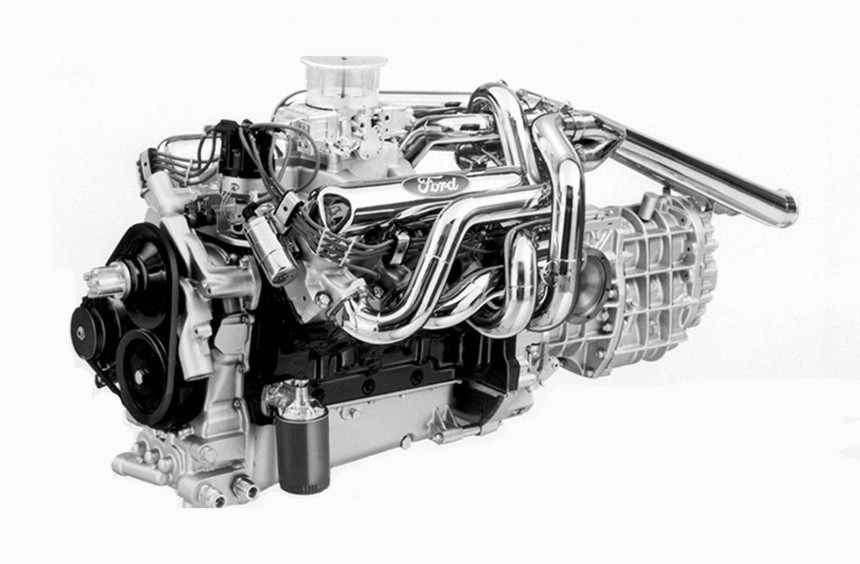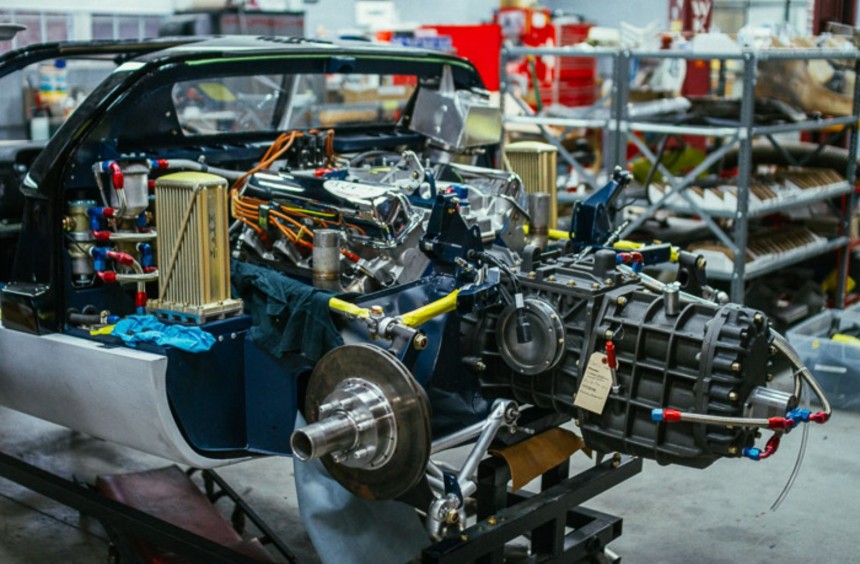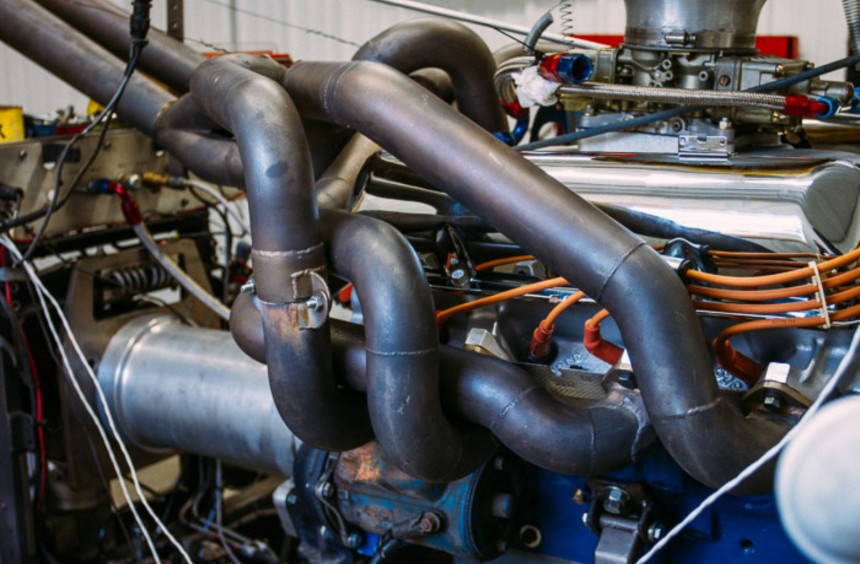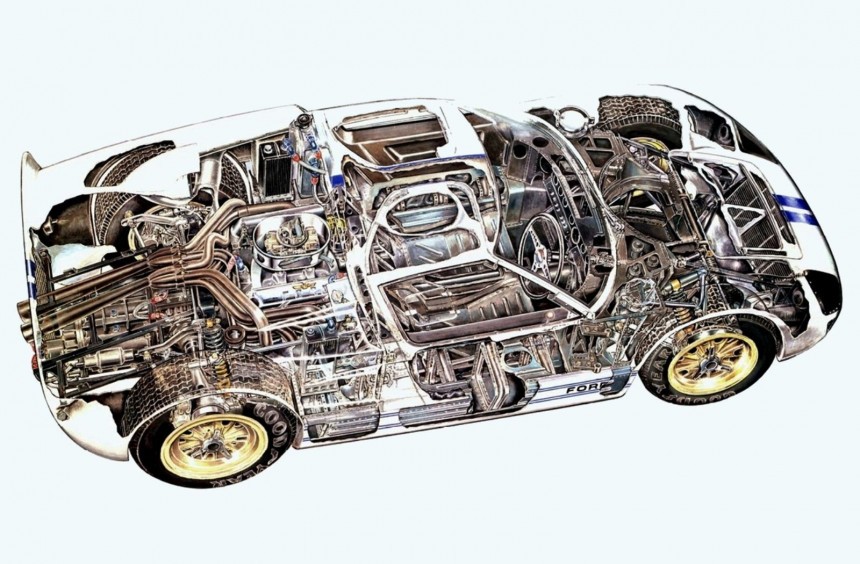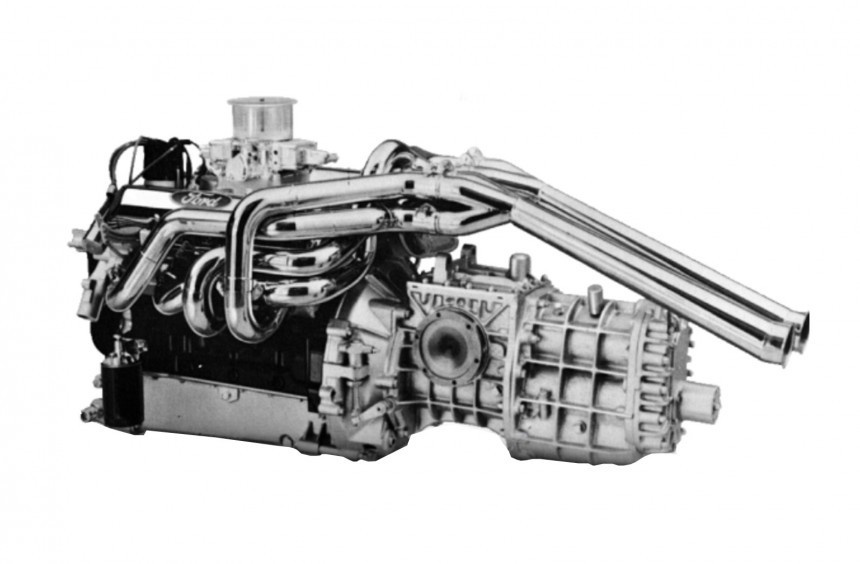This humongous V8 proved that American muscle was better than sophisticated Italian V12s on the biggest stage of them all: the 24-Hours of Le Mans.
This year marks the 100th anniversary of the 24-hour race held annually on the Circuit de la Sarthe in Le Mans, France. The event, which has become the oldest, most iconic race of its kind, was initially conceived during a period when Grand Prix motor racing was by far the most popular form of motorsport in Europe.
The idea was to offer the drivers and the public a new type of challenge: instead of focusing on building and racing fast cars, the aim was to push both driver and machine to the limit by competing for 24 hours straight.
This proved to be a great idea, and four decades after the inaugural race, the 24 Hours of Le Mans became one of the most prestigious motorsport events on the planet.
Drivers and manufacturers from all over the world were keen to compete. Still, by 1964, the French endurance race became an Italian affair, with Ferrari winning six of the last seven editions.
A few years earlier, Ford attempted to take over the Italian brand, but Enzo Ferrari used negotiations with the Americans as a way to get a better deal from the Italian conglomerate Fiat. The latter eventually took the reigns of the sports car company and gave Enzo complete control of the racing department dubbed Scuderia Ferrari.
The Blue Oval's failure to add the Italian brand to its portfolio, combined with Enzo Ferrari's arrogance and trickery, led to the start of a racing program meant to give birth to a car that would end Ferrari's dominance at Le Mans.
While Ford had the budget to create such a car, the corporation's racing department lacked endurance racing experience. Moreover, head honcho Henry Ford II wanted it done as soon as possible, so the team eventually sourced an existing Lola Mk 6 chassis as their building block.
The chassis was upgraded and eventually fitted with a race-spec 289-ci (4.7-liter) Fairlane V8 mated to a Colotti (later ZF) five-speed transaxle. The car, christened GT40 debuted at the 1964 Nürburgring 1000 km endurance race in Germany, where a suspension failure forced it to retire. Less than a month later, three GT40s were sent to Le Mans, but reliability issues forced all of them to retire as Ferrari claimed its fourth straight victory.
Later that year, the legendary Carroll Shelby was brought in to oversee the project, which, up until that point, had been a complete failure. Shelby, along with driver Ken Miles and engineering wizard Phil Remington began by improving the Mk I chassis, turning it into a much more polished race car that grabbed its first win at Daytona in February 1965.
Back in Michigan, Roy Lunn and his Ford team had developed a new version of the GT40, which, following the proven American saying "there's no replacement for displacement," featured a new 427-ci (7.0-liter) V8 that was guaranteed to provide more power while also increasing reliability throughout a grueling endurance race.
The new engine was built around the Gen II FE 427 block introduced midway through the 1963 model year on drag racing versions of the mass-produced Ford Galaxie and came from the company's NASCAR program.
Although its actual displacement was 425.98 ci (6.98 liters), the engine was called 427 because 7 liters (427 ci) was the displacement limit allowed by several racing organizations during that period.
While the cast iron block was shared with the 427s found in the drag-spec, fiberglass-paneled Galaxies, the gargantuan engine, which could only rev up to 6400 rpm, needed to lose weight fast in order to compete against Ferrari's smaller, lighter, and higher-revving V12 on the endurance racing stage.
Thus, Lunn and his team used a strong yet lightweight aluminum alloy to design a new pair of cylinder heads, an intake manifold, a timing cover, and a water pump. Moreover, the bulky stock oil pan was replaced with a cast magnesium variant that helped to shed weight even further.
Without the novel oiling system, which we'll get into below, the Le Mans version tipped the scales at 555 lbs (252 kg), 130 lbs (59 kg) less than a standard 427.
Since endurance racing was a different ball game than NASCAR or drag racing, the Le Mans version needed a series of unique adaptations to become genuinely competitive.
The first was developing a novel dry sump oiling system that featured both the high pressure and scavenge pumps inside the oil pan. This setup slightly lowered the center of gravity of the engine, while also eliminating the need for an external pump and belt.
Holley's Harold Droste designed central pivot float bowls for the 780 cfm four-barrel carb. Like the dry sump system, which was employed to optimize oiling through high-speed cornering maneuvers, these float bowls were created to prevent fuel sloshing – or, in simpler terms, to prevent fuel from moving erratically inside the carb during hard acceleration, deceleration, or cornering maneuvers.
Another unique innovation was the intricate exhaust nicknamed "bundle of snakes." Using a design pioneered in Formula 1 a few years earlier, the header featured tubes on each bank that crossed to the opposite bank to improve the exhaust scavenging effect.
Though it had a 10.5:1 compression ratio, which was lower than the Galaxie's 427, and could only rev up to 6,400 rpm – as opposed to the Ferrari V12, which could go past the 8,000 rpm mark – the Le Mans 427 could run very close to its max rpm for extensive lengths of time, making it much more efficient.
In the single-carb configuration and mated to a novel four-speed transaxle built by Ford's newly-established skunkworks department Kar Kraft the engine could produce 485 hp at 6,200 - 6,400 rpm and 475 lb-ft (644 Nm) of torque at 3,600 rpm.
As I mentioned, it was fitted inside a new, experimental GT40 chassis in the spring of 1965. Dubbed GT40X, the car was first tested by Ken Miles at the Romeo test track (aka Ford Proving Grounds) in Michigan. The Englishman was enthusiastic about the car's potential and immediately contributed to its development, asking to drive it at Le Mans.
The engineering teams of Shelby American and Ford managed to prep two GT40X cars for the famed endurance race in less than a month. Unfortunately for the GT40 project, the new gearboxes, which were rebuilt ahead of the race, failed on both cars. Ferrari won the race again. But this time, a privateer NART (North American Racing Team) car crossed the finish line first.
The GT40X was improved in the following months, resulting in the GT40 Mk II. This version addressed all the prior issues, helping Ford to an epic 1-2-3 finish at the 1965 edition of Le Mans. The engine proved its worth again in 1967 on the thoroughly redesigned Mk IV chassis that brought the Blue Oval its second consecutive Le Mans victory.
Ford continued its Le Mans domination with two more wins in 1968 and 1969, but for those two races, special, John Wyer-prepped Mk I GT40s powered by smaller, 302-ci (4.9-liter) V8s were used.
Thanks to the joint efforts of Ford, Shelby American, and Holman Moody (the NASCAR team which contributed to the project), the 427 Le Mans engine proved that American muscle could conquer Le Mans.
Nearly six decades after its maiden race, the V8 remains an engineering legend and one of the most successful race-bred powerplants ever conceived on US soil.
The idea was to offer the drivers and the public a new type of challenge: instead of focusing on building and racing fast cars, the aim was to push both driver and machine to the limit by competing for 24 hours straight.
This proved to be a great idea, and four decades after the inaugural race, the 24 Hours of Le Mans became one of the most prestigious motorsport events on the planet.
Drivers and manufacturers from all over the world were keen to compete. Still, by 1964, the French endurance race became an Italian affair, with Ferrari winning six of the last seven editions.
A few years earlier, Ford attempted to take over the Italian brand, but Enzo Ferrari used negotiations with the Americans as a way to get a better deal from the Italian conglomerate Fiat. The latter eventually took the reigns of the sports car company and gave Enzo complete control of the racing department dubbed Scuderia Ferrari.
The Blue Oval's failure to add the Italian brand to its portfolio, combined with Enzo Ferrari's arrogance and trickery, led to the start of a racing program meant to give birth to a car that would end Ferrari's dominance at Le Mans.
No replacement for displacement
The chassis was upgraded and eventually fitted with a race-spec 289-ci (4.7-liter) Fairlane V8 mated to a Colotti (later ZF) five-speed transaxle. The car, christened GT40 debuted at the 1964 Nürburgring 1000 km endurance race in Germany, where a suspension failure forced it to retire. Less than a month later, three GT40s were sent to Le Mans, but reliability issues forced all of them to retire as Ferrari claimed its fourth straight victory.
Later that year, the legendary Carroll Shelby was brought in to oversee the project, which, up until that point, had been a complete failure. Shelby, along with driver Ken Miles and engineering wizard Phil Remington began by improving the Mk I chassis, turning it into a much more polished race car that grabbed its first win at Daytona in February 1965.
Back in Michigan, Roy Lunn and his Ford team had developed a new version of the GT40, which, following the proven American saying "there's no replacement for displacement," featured a new 427-ci (7.0-liter) V8 that was guaranteed to provide more power while also increasing reliability throughout a grueling endurance race.
American big-block muscle on a diet
Although its actual displacement was 425.98 ci (6.98 liters), the engine was called 427 because 7 liters (427 ci) was the displacement limit allowed by several racing organizations during that period.
While the cast iron block was shared with the 427s found in the drag-spec, fiberglass-paneled Galaxies, the gargantuan engine, which could only rev up to 6400 rpm, needed to lose weight fast in order to compete against Ferrari's smaller, lighter, and higher-revving V12 on the endurance racing stage.
Thus, Lunn and his team used a strong yet lightweight aluminum alloy to design a new pair of cylinder heads, an intake manifold, a timing cover, and a water pump. Moreover, the bulky stock oil pan was replaced with a cast magnesium variant that helped to shed weight even further.
Without the novel oiling system, which we'll get into below, the Le Mans version tipped the scales at 555 lbs (252 kg), 130 lbs (59 kg) less than a standard 427.
The innovations that made the 427 Le Mans engine special
The first was developing a novel dry sump oiling system that featured both the high pressure and scavenge pumps inside the oil pan. This setup slightly lowered the center of gravity of the engine, while also eliminating the need for an external pump and belt.
Holley's Harold Droste designed central pivot float bowls for the 780 cfm four-barrel carb. Like the dry sump system, which was employed to optimize oiling through high-speed cornering maneuvers, these float bowls were created to prevent fuel sloshing – or, in simpler terms, to prevent fuel from moving erratically inside the carb during hard acceleration, deceleration, or cornering maneuvers.
Another unique innovation was the intricate exhaust nicknamed "bundle of snakes." Using a design pioneered in Formula 1 a few years earlier, the header featured tubes on each bank that crossed to the opposite bank to improve the exhaust scavenging effect.
A rough start, followed by two glorious wins
In the single-carb configuration and mated to a novel four-speed transaxle built by Ford's newly-established skunkworks department Kar Kraft the engine could produce 485 hp at 6,200 - 6,400 rpm and 475 lb-ft (644 Nm) of torque at 3,600 rpm.
As I mentioned, it was fitted inside a new, experimental GT40 chassis in the spring of 1965. Dubbed GT40X, the car was first tested by Ken Miles at the Romeo test track (aka Ford Proving Grounds) in Michigan. The Englishman was enthusiastic about the car's potential and immediately contributed to its development, asking to drive it at Le Mans.
The engineering teams of Shelby American and Ford managed to prep two GT40X cars for the famed endurance race in less than a month. Unfortunately for the GT40 project, the new gearboxes, which were rebuilt ahead of the race, failed on both cars. Ferrari won the race again. But this time, a privateer NART (North American Racing Team) car crossed the finish line first.
The GT40X was improved in the following months, resulting in the GT40 Mk II. This version addressed all the prior issues, helping Ford to an epic 1-2-3 finish at the 1965 edition of Le Mans. The engine proved its worth again in 1967 on the thoroughly redesigned Mk IV chassis that brought the Blue Oval its second consecutive Le Mans victory.
One of the greatest American engines of all time
Thanks to the joint efforts of Ford, Shelby American, and Holman Moody (the NASCAR team which contributed to the project), the 427 Le Mans engine proved that American muscle could conquer Le Mans.
Nearly six decades after its maiden race, the V8 remains an engineering legend and one of the most successful race-bred powerplants ever conceived on US soil.
